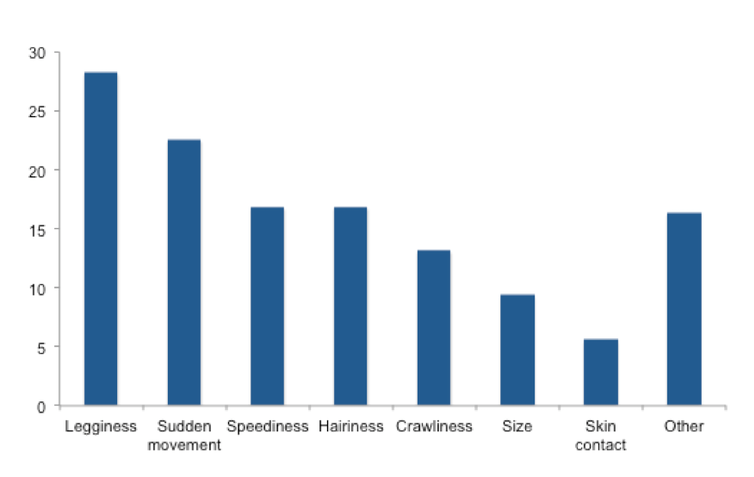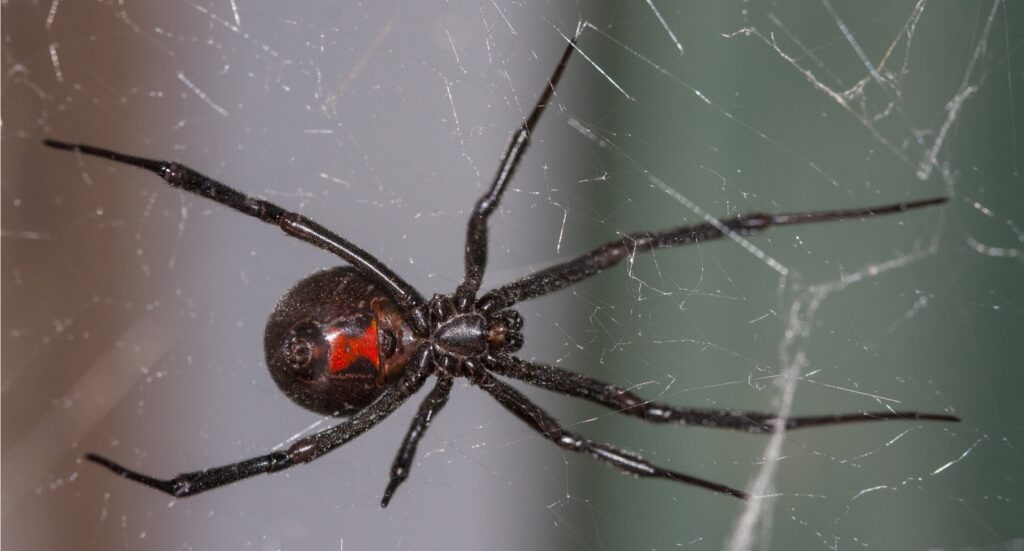If you are afraid of scary spiders in your home, you are not alone…besides the spiders.
In a 1991 City University of London study about 75% of the people sampled were either mildly or severely afraid of spiders. As the researchers dug deeper into why so many people are afraid of spiders they learned there was more to it than fear of getting bitten. We seem to dislike the looks of spiders and how they move more than anything. For some, contact with a spider web is enough to make them jump out of their skin. Look at the graph below. The legginess of spiders is the creepiest of all.

Big Hairy Scary Spiders in Florida
The wolf spider is one of the largest spiders in Florida. This one is usually the culprit when someone screams “EEEK, look at that big hairy spider!” and runs as far away as they can.
Wolf spiders can get about as large as a grapefruit but are brown with camouflage markings. They will jump, but will usually not pounce on humans. (Ok, that .05 percent of doubt that it could is enough to give you chills, right?)
However, wolf spiders are actually good to have around. “Wolf spider are harmless and, indeed, provide valuable pest control around our homes and yards because they eat pest insects,” says Nancy Hinkle, a professor in the Department of Entomology at the University of Georgia. “As might be guessed from their name, wolf spiders are hunters and stalk their prey.
Wolf spiders (Lycosa) aren’t deadly to humans, but they can still bite and cause uncomfortable symptoms. These spiders are found across the United States. A wolf spider bite isn’t usually a cause for significant concern because they’re not poisonous to humans.
Venomous Spiders in Florida
There are only two types of venomous spiders to be afraid of in Florida: widow spiders and recluse spiders. These are the real scary spiders in your home!
The Black Widow Strikes
Widow spiders are found all over the world, but only three species are native to Florida, and a fourth species has been introduced. The black widow image applies to all species, which are small, mostly black with red markings and moderately long, slender legs.
These spiders are nocturnal and build a three-dimensional tangled web, often with a conical tent of dense silk in a corner where the spider hides during the day. In nature, most species are found under rocks and logs, but they readily adapt to human-altered environments, where they are most commonly found in sheds and barns, water meter holes, nursery cans, and under any item or structure (e.g., barbeque grill, slide, sand box) that has been undisturbed for a while

So Recluse We Rarely See Them
Not one species of recluse spiders are native to Florida, but three species have been found and occasionally have established populations in single buildings at scattered locations. Luckily for us, we have not seen recluse spiders in Sarasota and Manatee counties. But let’s not jinx it by saying they are not there!
The brown recluse has been found in Alachua, Bay, Duval, Jefferson, and Leon counties. It typically has a dark violin-shaped mark, although the color is variable.
The Mediterranean recluse has been found in Dade, Escambia, Orange, and Osceola counties. It is very similar in appearance to the brown recluse, but the violin mark tends to be lighter in color and has parallel sides.
The Chilean recluse has only recently been found in Florida, in Polk County. It is the largest and most dangerous of the recluse species. The violin mark of this species is dark and wider in front than behind.
Both types of spiders tend to be found in similar places, which is in or under objects where their presence is not necessarily obvious. It is a general safety rule for people who are lifting, moving, digging, exploring hidden places with their hands, wear garden gloves! You might also be wise to check clothing and fabric that has been stored for a while as little spiders like to hide in folds. (Yeah, that’s a bit scary.)

Curious About What That Is?
We love this online site which is a public friendly spider ID resource. Look at the photos and figure out what type of spider that was that you saw. If you don’t find your answer and want some extra help, call us at Heath Pest Control!
What’s the Best Way to Get Rid of Indoor Spiders?
Overall, spiders are beneficial because they’re predators and feed on pests like flies. Most spiders cannot harm people. Those that might injure people — those widows and recluses — generally spend most of their time hidden under furniture or boxes, or in woodpiles, corners or crevices. The spiders that we commonly see out in the open during the day are not aggressive toward people. Spiders enter houses and other structures through cracks and are also carried inside on plants, firewood and boxes.
According to the UC IPM Spider Management Guidelines, the best approach for controlling spiders in and around your home is to remove hiding spots for secretive spiders such as black widows, and regularly brush or vacuum webs from windows, corners of rooms, storage areas, basements, and other seldom-used areas. This is effective because their soft bodies generally cannot survive this process. If you see a dust-covered web indoors, it is no doubt an old web that a spider is no longer using.
Want Some Help with the Scary Spiders in Your Home?
Go ahead and call us for an inspection. We will know what to do to keep your home safe and give you peace of mind. Contact Heath Pest Control. You can also request a visit at this link.
